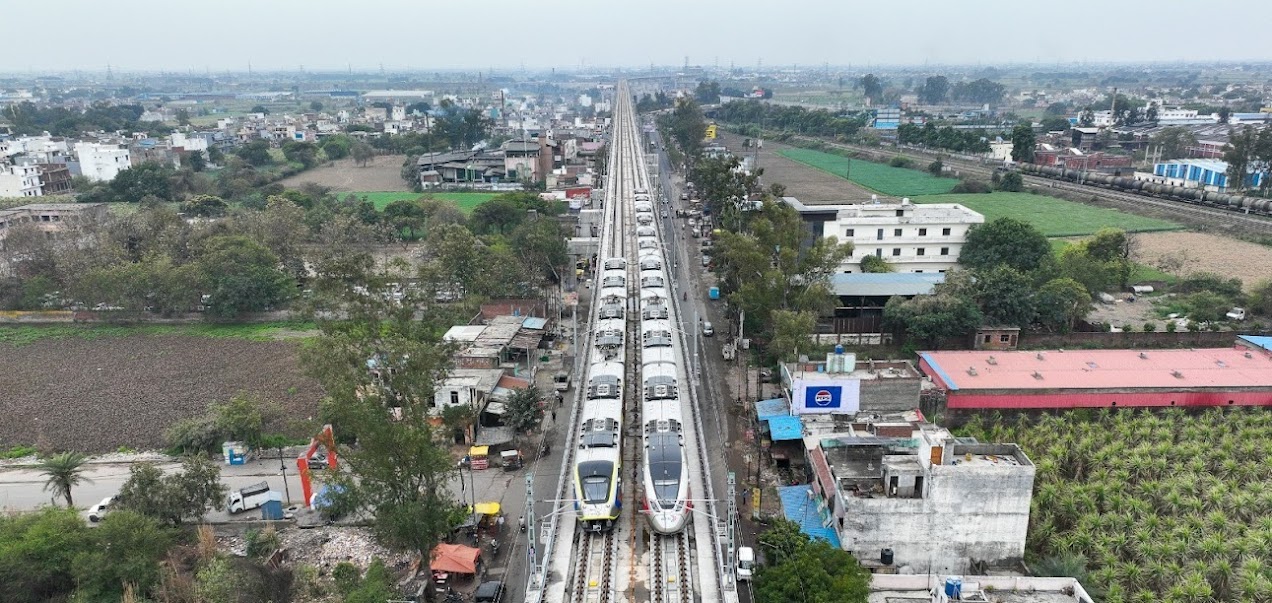In a significant move, Namo Bharat and Meerut Metro will soon operate on shared infrastructure—the first such integration in India. Enabled by cutting-edge ETCS Level-2 signalling over LTE and centralized control, the system allows safe, high-speed, and seamless travel across Delhi, Ghaziabad, and Meerut with unified ticketing and commuter travel convenience.
Introduction:
Representing a major stride for Indian urban mobility, the Namo Bharat semi-high-speed RRTS and the local Meerut Metro are set to operate on the same tracks in the Delhi-Ghaziabad-Meerut corridor. This exemplary integration, being introduced for the first time in the country, is expected to transform multimodal transport efficiency, commuter convenience, and intercity connectivity.
The shared infrastructure will allow a smooth transition between long-distance semi-high-speed travel and short-distance urban metro rides. It is expected to be a game-changer for lakhs of daily commuters traveling across Delhi NCR and Western Uttar Pradesh.
Key Features of the Integrated System:
- Shared Infrastructure– Namo Bharat (operational at 160 kmph) and Meerut Metro (operational at 120 kmph) will run on the same 82-km RRTS corridor from Sarai Kale Khan to Modipuram.
- Speed and Frequency– Namo Bharat currently operates at 15-minute intervals, which will soon minimise to 10 minutes. Meerut Metro will run every 7 minutes over its 23-km, 13-station stretch.
- Centralized Operations– The system is managed from a single Operations Control Centre (OCC) using the European Train Control System (ETCS) Level-2 over LTE—a world first. Integrated with ATP, ATS, and Platform Screen Doors (PSD), the system provides top-notch safety, speed regulation, and operational efficiency.

Commuter-Centric Design and Interchanges:
- Island Platforms– At key interchange stations like Begumpul, Shatabdi Nagar, Modipuram, and Meerut South, trains going in the same direction will arrive on either side of a single platform. This design eliminates the need for stairs or lifts, making the switch effortless.
- Unified Ticketing– A single ticket will cover journeys involving both Namo Bharat and Meerut Metro. Tickets can be booked through counters, vending machines (supporting cash, card, and UPI), or the Namo Bharat Connect app, which also includes a Journey Planner.
- Third-Party App Integration– Ticketing is being integrated with DMRC and IRCTC, enabling passengers to book Metro and Namo Bharat rides from multiple platforms.
Differentiation in Design, Unified in Purpose:
- Train Configuration:
- Namo Bharat: 6 coaches (1 premium, 1 reserved for women).
- Meerut Metro: 3 coaches with proper seating for women, senior citizens, and differently-abled.
- Color Schemes:
- Namo Bharat trains sport maroon stripes.
- Meerut Metro uses parrot green markings with the Indian Tricolor on the front.
Station Coverage and Modal Connectivity:
The integration connects 16 Namo Bharat stations and 13 Meerut Metro stations, with intermodal connectivity to Indian Railways, bus depots, and other metro lines. Notable station details include-
- Underground Stations: Meerut Central, Bhaisali, and Begumpul
- Elevated Stations: Remaining 10 stations
- At-Grade: Modipuram Depot
- Shared Stations: Meerut South, Shatabdi Nagar, Begumpul, and Modipuram offer both services.
These stations are engineered to facilitate effortless multimodal transfers with focus on accessibility, last-mile connectivity, and smooth commuter movement.
A Model for Future Urban-Rail Synergy:
This ambitious amalgamation of semi-high-speed and metro services shows a paradigm shift in India’s public transport planning. By sharing infrastructure and synchronizing services, the system sets a precedent for efficient resource utilization, reduced capital expenditure, and commuter-centric innovation.
The project not only improves travel between Delhi and Meerut but is also poised to inspire similar models in other cities, ushering in a new era of integrated, fast, and accessible public transport.
Conclusion:
The shared infrastructure model of Namo Bharat and Meerut Metro is a landmark in Indian rail transport. Through advanced signalling, centralized control, and commuter-focused design, the integration ensures safer, faster, and smarter mobility. As it unfolds, this initiative may redefine how Indian cities build their multimodal transport future.
Source: NCRTC | Images Credit: NCRTC
Join us to showcase Innovation in Rail & Metro sector of India- Book your Delegate Pass: https://railanalysis.in/info/delegate.html
![]() Timely insights, straight to your WhatsApp—stay updated with ease!
Timely insights, straight to your WhatsApp—stay updated with ease!


